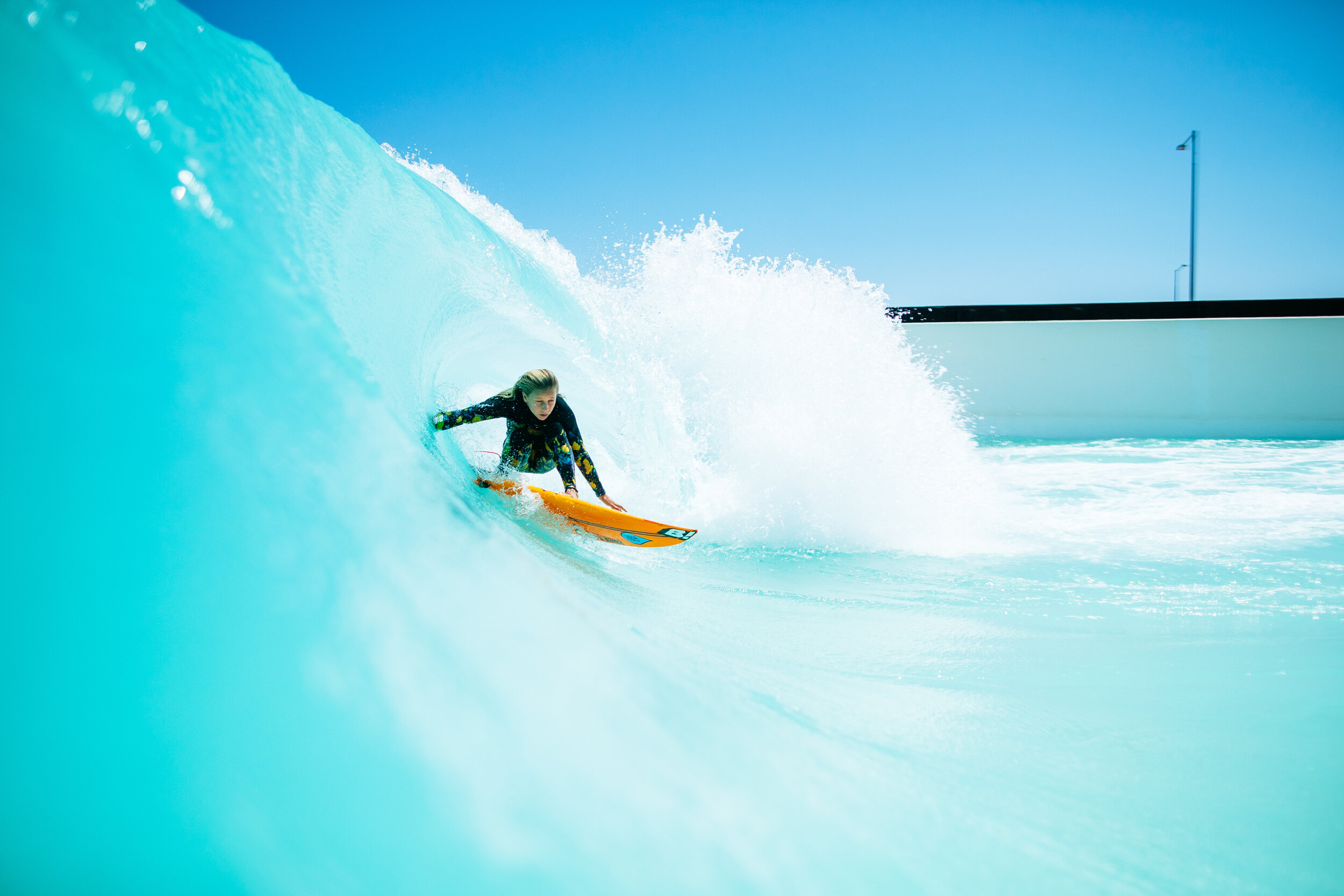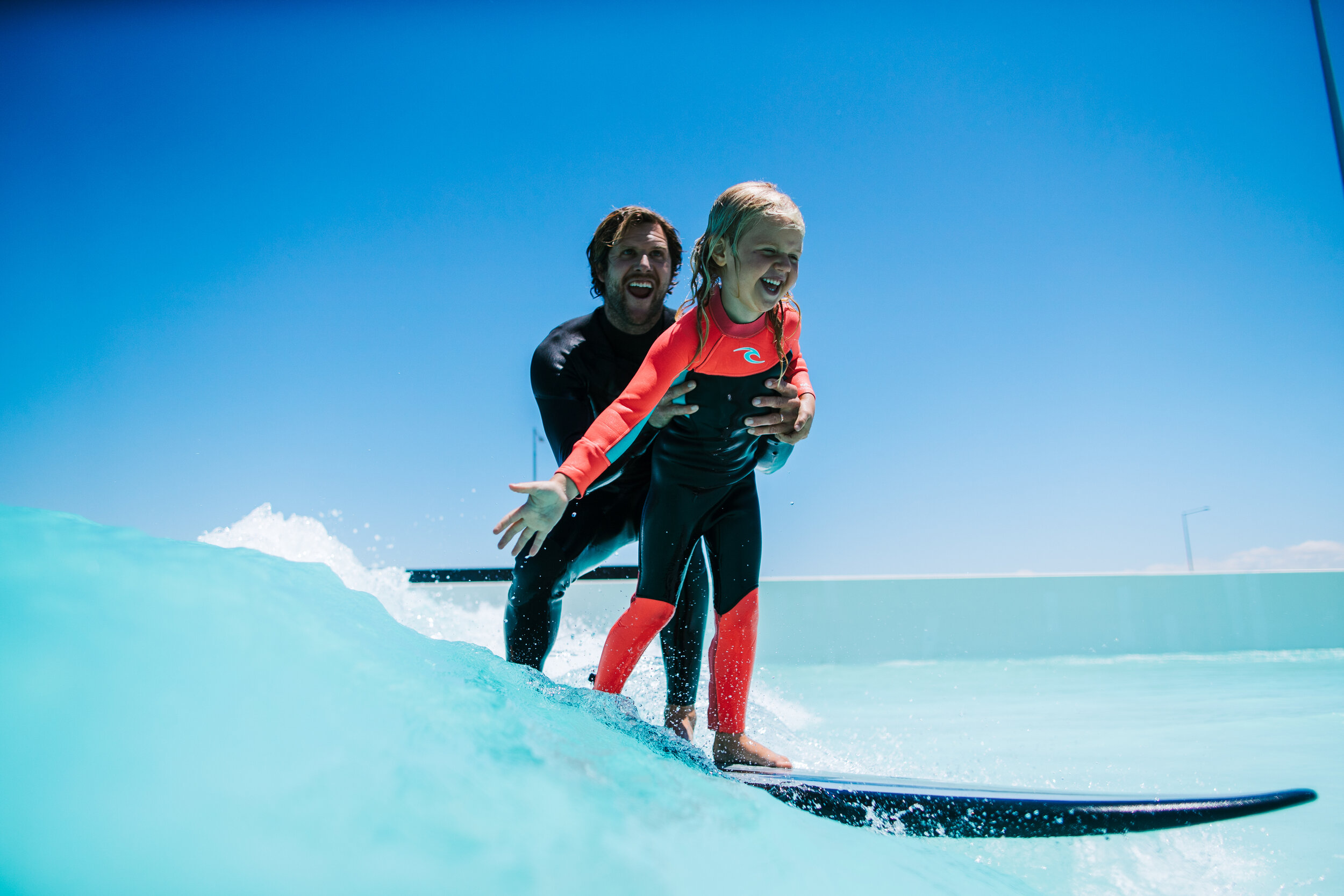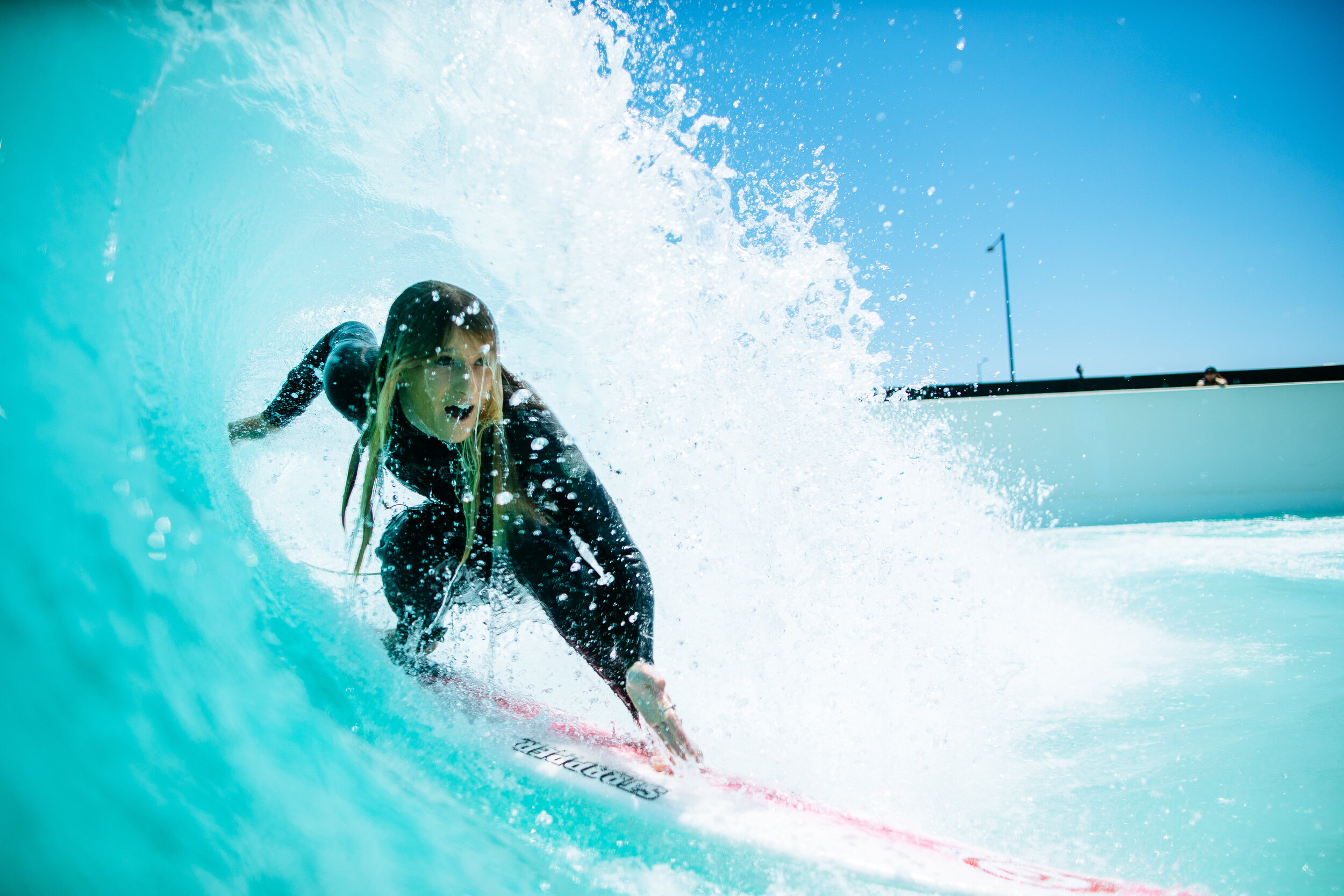CITY TO SURF
Words: Tim Baker.
Photos and video courtesy UrbnSurf
While it only takes about 25 minutes to drive from Melbourne’s CBD to the UrbnSurf wave park, it’s been almost a 10-year journey to realise its founder’s audacious vision
Andrew Ross spent 12 months sitting in a cell in Fremantle gaol dreaming up the vision that would become Melbourne’s ground-breaking wave park, UrbnSurf, the first of its kind in the southern hemisphere.
Ross hadn’t committed any crime, unless you consider throwing in a successful career in corporate law to pursue an outlandish dream against all odds recklessly criminal. Parts of the historic gaol, decommissioned in 1991, had been converted to office space and Andrew, recently turned 40, had decided to take a step back from his corporate career and reconsider his life’s path. The world heritage listed, sandstone prison, built in 1855, proved the ideal place to do a bit of soul searching, as it no doubt did for many of its inmates over 136 years..
That fateful sabbatical ultimately led Andrew to San Sebastian in Spain and the first protoype of Wave Garden’s surfing lagoon, and a surf session in waist high waves that would change his life. Andrew had read about a patent dispute between world champ Kelly Slater and surfboard shaper Greg Webber over their rival, circular wave pool technologies, both in their infancy. As a lifelong surfer and lawyer, the issue combined two of his key interests.
He contacted both parties, fascinated by the potential of artificial waves, then learnt that a Spanish company, Wave Garden, had already built a 2/3 scale prototype of their own design near San Sebastian in northern Spain. He reached out to Wave Garden founders Josema Odriozola, an engineer, and his wife Karin Frisch, a sports economist, both keen surfers, and received an invitation to visit their facility.
Thus, Ross found himself driving through the verdant Basque countryside on an unlikely surf trip, still sceptical about its potential. “I thought, it’s just going to be a fun story to tell my mates back in Perth,” Ross told the Future Squared podcast in 2020. But his mindset was about to quickly change. When he arrived at the secluded valley where Wave Garden was located, pro surfers Taj Burrow and Gabriel Medina were among those enjoying the small, perfect waves, but the Wave Garden founders ushered their potential investor to the front of the queue.
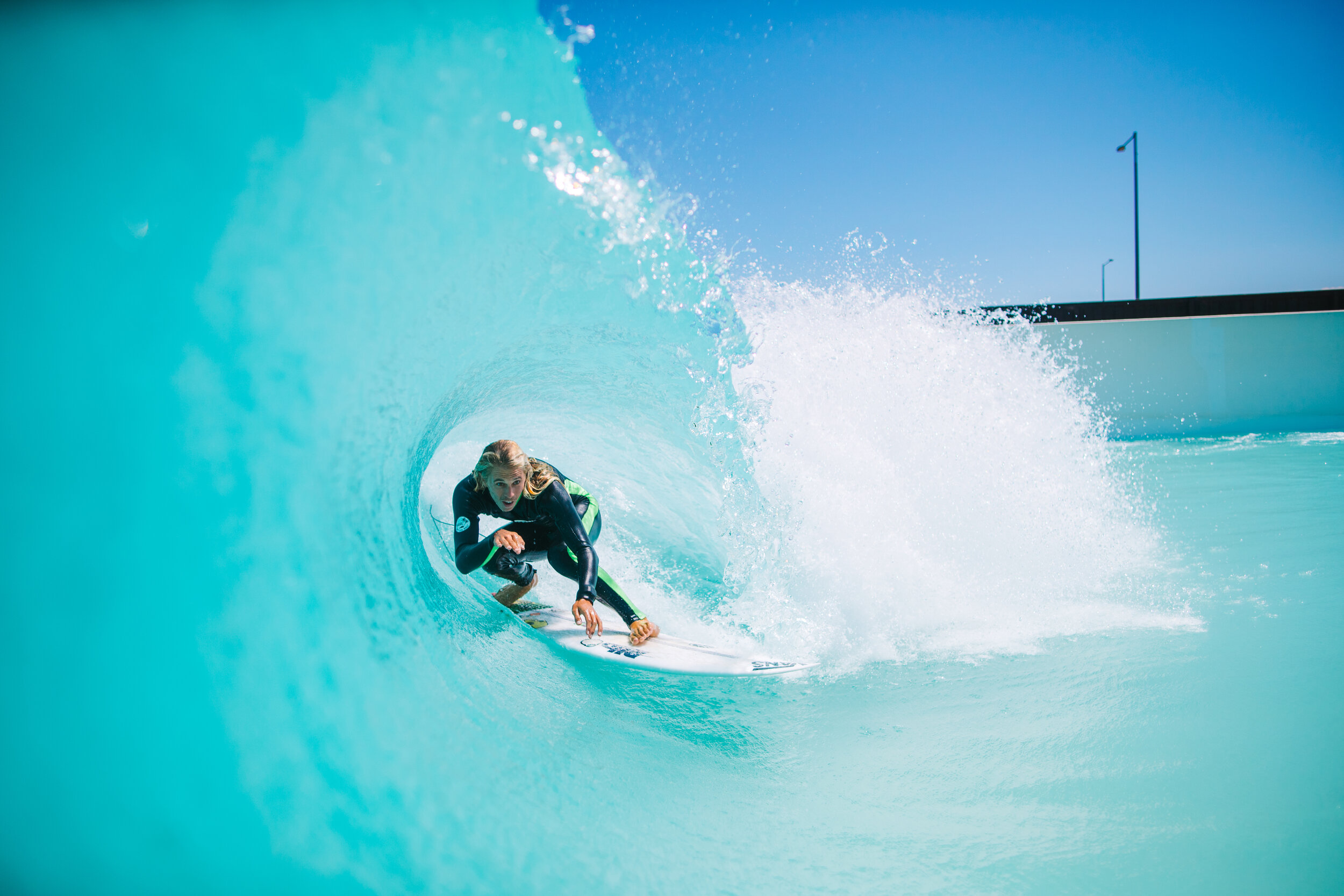
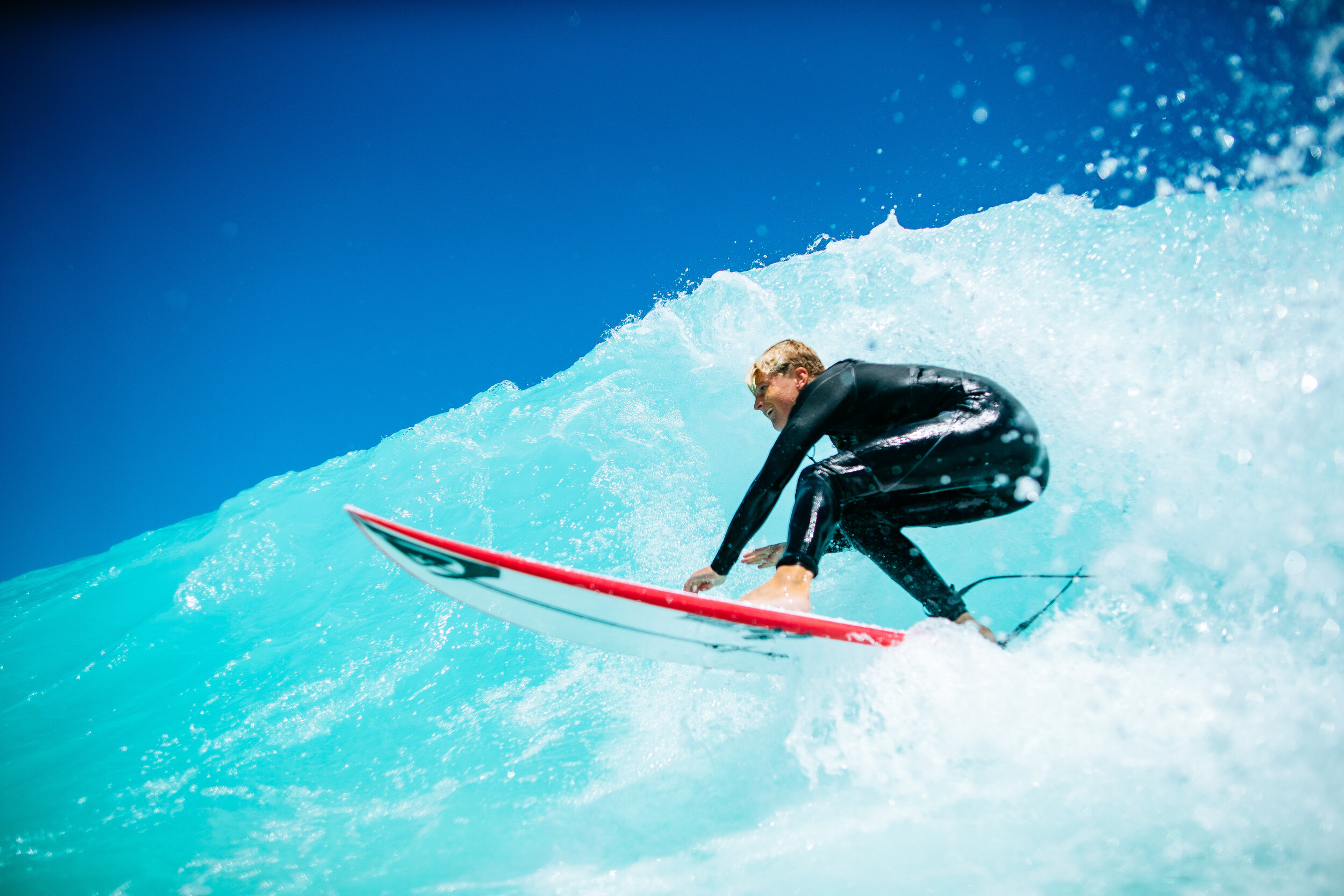
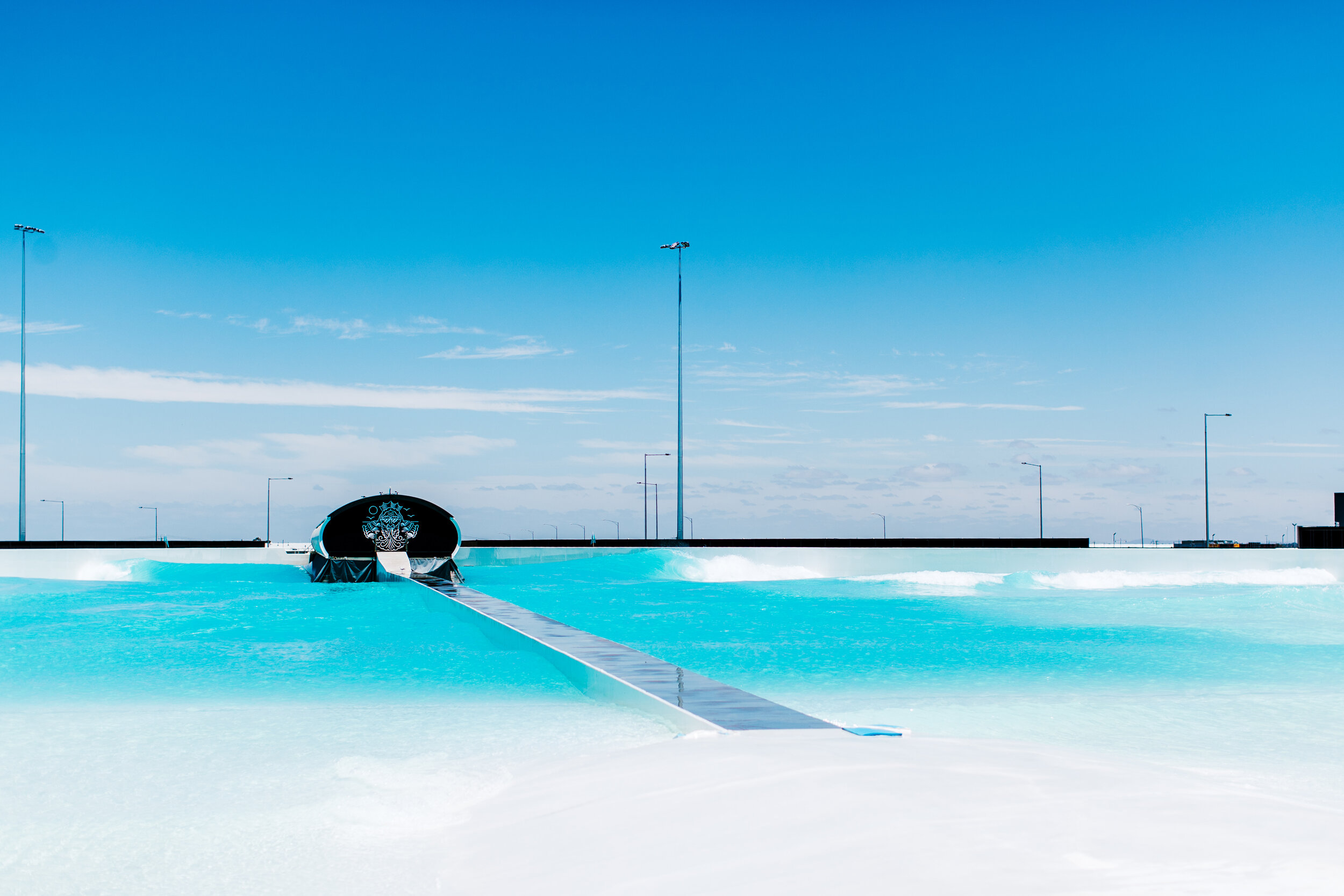
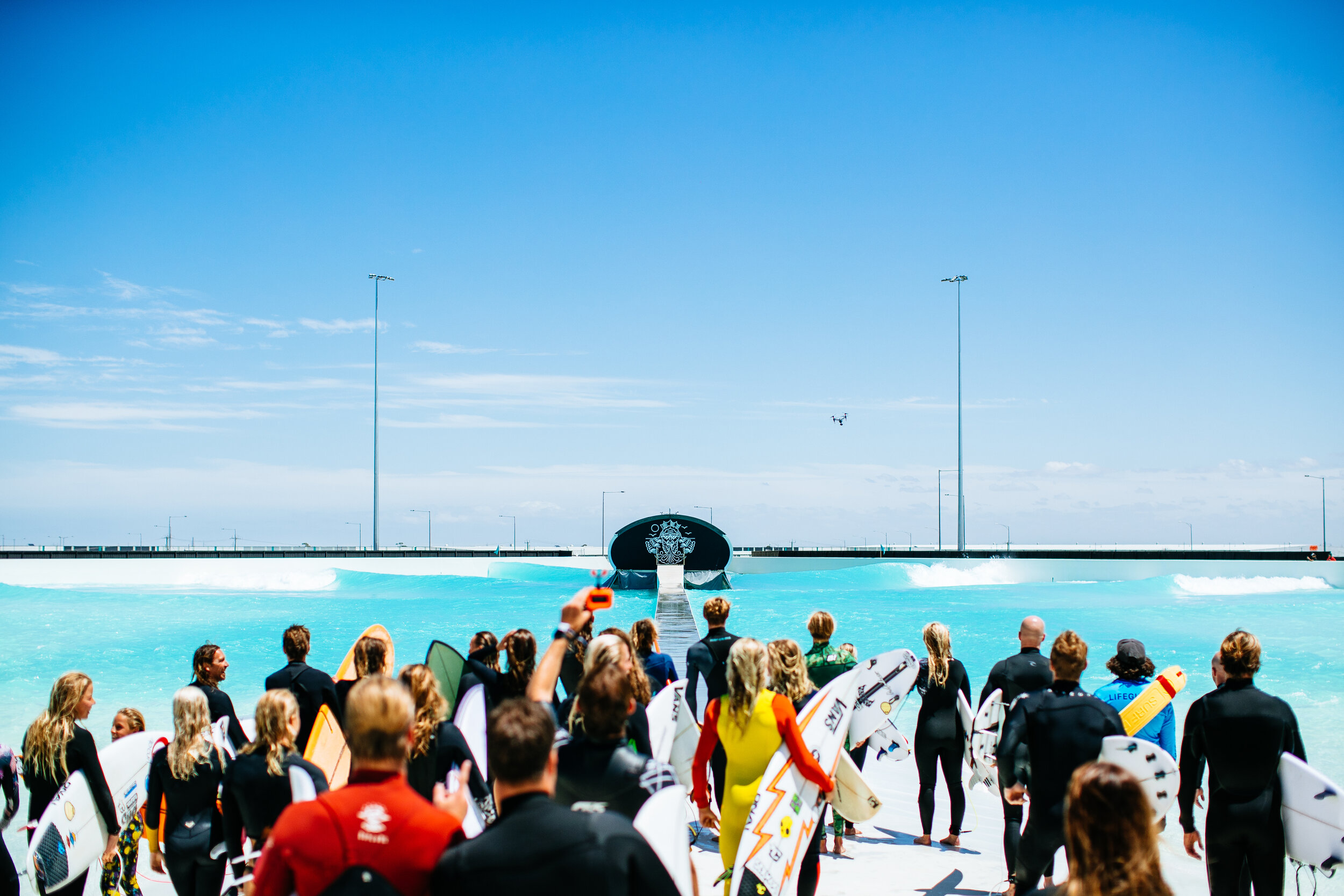
“I remember surfing my first wave. I kicked out and went, oh my god, they’ve actually cracked it. This is real. I need to be a part of this,” he says. “Surfing that very first day was almost like being hit by lightning.” Andrew still remembers the date – September 12, 2012.
Ross bought the rights for the Wave Garden technology for WA on the spot, and soon after he bought the rights for the rest of Australia. “This will be an interesting thing to do in my year off,” he mused. Little did he realise this “brain fart,” as he calls it, would launch a nearly 10-year journey to bring a Wave Garden facility to Australia.
It’s a similar Eureka moment experienced by almost every surfer who walks through the entry of UrbnSurf for the first time, conveniently located next to Melbourne’s Tullamarine airport: Oh my god, they’ve done it! It is your every grommet fantasy brought to life. Perfect lefts and rights running down either side of a large pool, roughly the size and shape of a baseball field, with a pier running down the middle to house the wave generator.
But not all of us write a fat cheque on the spot and spend years raising millions of dollars in capital and overcoming the planning, logistical and commercial challenges required to build one of these things ourselves. Corporate law and investment banking are deeply pragmatic, hard-nosed professions. What possessed Andrew to throw everything down on an untested business model with a wild, “build it and they will come” idealism?
Andrew doesn’t seem like the type to make rash business decisions, but he had been looking for a business opportunity that combined his profession and his passion. Wave pools were an obvious fit. And it met another of his key business criteria. “I need to find something that exists somewhere else in the world that doesn’t exist in Australia and bring it to Australia,” he’d decided during his sabbatical.
Fortunately, Andrew was well qualified in both raising capital and managing risk. He’d started his own oil and gas company at the age of 33 and raised $40 million. Wave Garden only required $30 million and involved less chance of things bursting into an apocalyptic hellfire. And he got to go surfing.
While it might all sound like a fanciful, mid-life crisis-fuelled leap of faith, Andrew didn’t completely throw out his naturally analytical and diligent business principles. What he did next was, well, to the untrained observer, nothing.
New arrivals at UrbnSurf lose their minds at the first glimpse of the pool
“He had an office in the historic Fremantle gaol, and he sat in his cell for a year thinking about: What’s the business model? What’s the brand? What boxes do we need to tick to deliver a memorable experience affordably? What are the problems that need to be solved? How does it fit into surfers’ existing habits and experiences?” explains marketing manager Rupert Partridge, one of UrbnSurf’s early hires, from a background in law and property and retail consultancy.
Next came the challenge of finding a suitable site. Andrew was born in Geelong, close to the Surf Coast of Victoria but grew up in Perth. His hometown in WA ticked plenty of boxes – lots of surfers, local surf conditions that are rarely ideal. A short commute to a metropolitan wave pool versus long travel times to access the quality waves of the south-west, Rottnest Island or the coast north of Perth had obvious appeal.
“Finding a big enough parcel of land in a metropolitan area is difficult,” says Rupert. “Finding the right sites with the right amount of land close enough to enough people to service that population to under write the business.”
Ultimately, Andrew’s birth state of Victoria won out over his home state of WA. A 5.4-hectare site close to Melbourne’s Tullamarine Airport, earmarked for a Disney theme park, proved irresistible when the airport approached UrbnSurf with an offer to lease the site.
“We’d had numerous discussions with landowners, but we jumped at it,” says Rupert. “Melbourne is at least an hour and a quarter to the coast. It’s a half to full day commitment. Surfing before or after work is really hard for Melbourne-based surfers.” Rupert should know, having tried getting up at 3 am to get to Winki Pop for first light a few times, and still make it to work through peak hour traffic by 8:30. By the time he got to work, “I was ready to go back to bed,” he says.
Melbourne’s large, land-locked surfing population, tied to the city through work or family commitments, offered a ready and eager market. “If they’ve got a partner and family, to dedicate a half or full day on the weekend to surfing is a stretch,” says Rupert. “We talk a lot about finding a window. We figured we’ll provide the opportunity for those guys to find a window, a location north of the city to get tubed, whack a couple of turns, have something good to eat, without having to drive three hours round trip to get it.”
What followed was 18 months of master planning the site, dealing with approvals, architectural plans, business models, branding, fund raising, before an unexpected call from Spain sent them back to the drawing board. “At the 11th hour Andrew gets a call from the Wave Garden people – ‘We’ve come up with this new technology, you might want to hold off’. That was the Cove,” says Rupert.
The Cove was a quantum leap ahead of the original Lagoon design with increased capacity and greater variability of wave types, including legitimate barrels. In the race to compete with rival wave parks, this was a major breakthrough. Andrew flew to Spain to experience the new technology and needed no further convincing. Plans were redrawn, new approvals were sought, investors were flown to Spain to see the new iteration firsthand.
With the capacity to accommodate 18 surfers on the left, another 18 on the right and up to 24 beginner surfers in the reform waves, in the so-called Bay, on each side, the Cove was a game changer. Servicing up to 84 surfers per hour made the economics of the whole deal more viable and the experience more affordable for more surfers.
The new approvals took another 12 months, construction began in early 2018 and took a full 18 months. “The topography map was so complicated, it looked like a plate of spaghetti. We had eight grading machines connected by GPS working together, with a 5 mm tolerance. That level of sophistication is the kind of secret sauce,” says Rupert.
They needed a month of fine weather to lay the bottom of the pool, but Melbourne’s notoriously fickle climate proved uncooperative, and near-constant rainfall delayed construction further. 18,000 tonnes of recycled concrete from the airport were re-purposed in the build, making it the largest recycled concrete structure in Australia.
Then, finally, seven years after Andrew’s fateful drive through the Basque countryside, the moment of truth arrived. The new pool was over 20,000 square metres, or 2.2 hectares. It cost $30 million dollars and required 23 million litres of water, or 16 Olympic swimming pools, to fill it. But would it work?
“We filled the lagoon, we’d done everything we needed to do to make it work like clockwork, but we hadn’t turned it on. We didn’t know how the machines would work. It really was a Hail Mary, but we had great confidence in Wave Garden,” says Rupert.
They flicked the switch and held their breaths. “Immediately we had three great waves, but it was untuned. It’s like having a computer without the software. It works but you’re not getting the most out of it,” says Rupert.
The UrbnSurf team with the help of Wave Garden technicians embarked on a concentrated period of wave development, surfing, giving feedback, adjusting settings, until they produced desirable conditions for various levels of surfers.
Central to the UrbnSurf wave pool is Roary the wave generator, nicknamed after that other generator of swells, the Roaring Forties. A complex drive system controls 46 pistons, each attached to a paddle. “You can change the setting between sets. The interface looks almost like a Spotify playlist,” says Rupert. “The speed, power, and torque you program each of them creates different kinds of waves. For barrels, the first quarter of the pistons are slower, the second and third quarter go really hard, and the fourth you are slackening the power off.”
Finally, they opened in January 2020 to an enthusiastic reception. Melbourne surfers were quick to embrace the facility. The proximity to the airport meant interstate surfers even staged FIFO missions to come and surf the pool. After such a high stakes punt, the future looked rosy, with sessions fully booked for weeks in advance. But the challenges were not over.
Soon after opening, a dust storm blew through Melbourne, and it literally rained mud, turning the sparkling pristine waters of the pool a chocolate brown. “It was like we’d bottled lightning and upset someone upstairs,” says Andrew. He joked that he was half-expecting a plague of frogs next. But frogs would have been a minor setback compared to the plague that was about to beset the world.
UrbnSurf had been open for just ten weeks when … everything changed. The COVID-19 pandemic meant they had to abruptly close their doors as Victoria went into hard lockdown. After eight years of work, the forced closure must have been heart breaking, but the UrbnSurf team seemed to take it in their stride, bringing forward mid-Winter maintenance, developing new cruiser and expert wave settings to complement the intermediate and advanced sessions, and refined their surf lesson program to offer a four-step pathway from beginner to intermediate.
“We now have ten different turn waves, and eight different barrel settings. We can create sessions and experiences for every type of surfer,” says Rupert. Their notorious “Beast Mode” produces the heaviest barrels and most spectacular photos, but an experimental “Beast Plus,” proved too sketchy. “A guy blew all three fin boxes out, and snapped off the tail of his board hitting the bottom. We decided we’re going to hide that mode for a while. That’s the exciting part of the wave development process.”
They opened for three weeks in June/July before Victoria’s second wave forced them to close again, for another four months. This time they worked on the park surrounds and facilities, put the finishing touches on a Three Blue Ducks restaurant and café on site, and finally re-opened in November.
“We had a really busy summer. Travel restrictions helped us a lot, and we had a lot of support,” says Rupert. “As soon as the domestic borders opened, in particular NSW, they came flooding down.”
It’s humbling to think I am to be the beneficiary of this whole gruelling process, as I head north out of Melbourne on the Tullamarine Freeway, past the infamous “cheese stick” public art piece, past the industrial estates and factory outlets and new housing developments. Once, the only surf trip this charmless journey could be the beginning of was one that involved flying to distant and exotic shores from Tullamarine Airport.
There aren’t many of us visiting any distant shores just at the moment, exotic or otherwise. And so, this busy urban commute has become a well-worn path for wave-hungry surfers starved of their annual fix of Indo boat trips or Hawaiian missions, or even a simple trip to Byron or the Goldy.
I turn off just before the airport, past chicken shops and pizza joints, 7-11s and milk bars, car rentals and airport hotels. The Essendon AFL’s team’s training ground, the Hangar, looms up on the left, where bored suburban dads park their cars and stand at a cyclone fence and watch players train. It’s hard to imagine an environment that feels less surf-like.
Soon I spot a concentration of black shipping containers piled one on top of each other behind a high metal fence. Despite appearances, this isn’t some international freight business. Turn left into the gravel car park and you find yourself at the entry to a surreal oasis on the outskirts of the airport. Cars with boards inside or on the roof are coming and going – tradies in hi-ves squeezing in a sesh between jobs, businessmen ducking out in their lunch break, car loads of mates looking for a fix now that Mentawai trips are out of the question, surf school groups. The car park is packed on a weekday lunch time when I first lob at UrbnSurf for my debut in the pool.
I’m getting strong theme park vibes as I approach the front counter to check in – Wet’n’Wild for grownups. I’ve booked a couple of sessions a day for three straight days to give the thing a thorough going over in cruiser, intermediate and advanced sessions. It’s busy with surfers checking in and the crew on the front desk are friendly, prompt and efficient. I fill out an electronic waiver form on a touch screen, receive my wrist band that records all my account details, I flash it under a little scanner at the entrance and the turnstile thingy magically opens for me and I’m in. Before I’ve had a chance to orient myself there it is.
I’ve seen the clips, read a few online accounts of surfing the pool, spoken to a couple of mates who’ve partaken, yet nothing prepares me for the spectacle before me. I stand and watch dumbly in awe, eyes agog, as perfect lefts and rights peel away.
Even though there are smart change rooms and lots of spaces to leave your stuff in converted shipping containers or under sun shelters or in lockers for hire, it’s oddly pleasing to see most surfers get changed under their towels on the grass in front of the pool like it’s any other surf break. There seems to be an admirable trust system where everyone leaves their stuff lying around during surf sessions.
I’ve booked in last minute so have to take what spots are available, which means my pool debut is an advanced session on the left, a baptism of fire for a 56-year-old natural footer from the Gold Coast of upper intermediate ability at the best of times, who rarely goes left. I’m a bundle of nerves. A hasty trip to the loo is required and by the time I get into my wetsuit and put on some zinc it’s time for the pre-surf briefing.
We gather on the lawn by the lifeguard tower as one of the instructors explains the rules. We paddle out single file next to the pier and wait our turn. We’re told to stay well clear of the pier as when it starts generating swell you can get sucked towards it and people have lost fins on its wire mesh. When it’s your turn and you miss a wave or fall, you go back to the end of the line, in which case you should turn and catch the whitewater in as quickly as possible to get out of the impact zone, so you don’t get in the way of the next surfer. This is crucial advice because when the waves start-up they are extremely close together, like a short period swell. If a couple of surfers blow the take-off in succession things can quickly get messy. All this does little to ease my nerves.
And then, we’re off. It’s easy to hear the purists mocking the whole process, surfers flashing wrist bands under scanners to get access to the waves, paddling out single file in neat rows to wait their turn on the artificial wave machine, the uniformed instructor issuing directions, the whirring of the machine, the high concrete wall you take off next to. It’s all a long way from the sense of escape and freedom that drew most of us to surfing. And yet … there’s something so magnetically hypnotic about the whole thing, I’m as excited as a kid at Christmas when I copped eyes on my first foamie under the tree.
The theme park vibes kick in again as I get close to the front of the queue, like waiting to get on a rollercoaster. I haven’t rushed out so I get to see how other surfers approach it, and it looks like a reasonably easy take off, despite the advanced setting. Yet when my turn comes, I’m freaking out. The surfer in front of me takes a wave, I paddle into position, the water starts receding as a swell builds in the narrow little corner of the pool between the pier and the concrete wall and I turn and paddle like my life depends on it. I’m intent only on not blowing the take off and disgracing myself in front of the dozen or so surfers waiting their turn.
Mercifully, I make the drop and take a low-risk approach to the wall that presents itself with a couple of gentle cutties and kick out, heart pounding. There’s anywhere from a dozen to a maximum of 18 surfers on each side of the pier, and generally around 12 waves per set, with only a few seconds between waves and a couple of minutes’ break between sets, so the queue moves quickly. The hardest thing to get used to is how fast you need to react when your turn comes. You can be fifth or sixth in line but when a set starts up, you’re at the front of the queue before you know it. What proves particularly pleasant is how happily everyone takes it in turns, without any jockeying or hassling, even letting surfers who’ve blown a wave jump back in near the front of the queue.
It’s a tight little take off area and you need to turn around and go without hesitation. It feels a bit claustrophobic initially in the narrow space between the wave generator and the wall with little room for error. Halfway through the advanced session they crank the machine up a notch and magically a legit barrel section opens up and you are faced with little choice but to pull in. Backhand tube riding has never been my strong point. I find a variety of ways to blow the barrel section and never truly come to grips with it. It’s an inauspicious debut.
My initial feeling is, that was fun without being mind-blowing, but it proves weirdly addictive. I have an hour’s break before an intermediate session on the left and, ideally, I probably should have had them the other way round. But within half an hour of getting out of the pool, like some other addictive experiences I’ve heard about, I’m hanging out for my next fix.
The Three Blue Ducks restaurant on site seems popular even with those not surfing, well-dressed Melbourne dames sipping wine, airport workers and business people enjoying long lunches and oohing and aahing to the surfing. The more casual café caters for those with limited time or budget. I opt for the café between surfs and get a tasty dahl with flatbread which is excellent. Another day I go for the vegetarian wrap which is also good and reasonably priced. Importantly, their coffee is top quality.
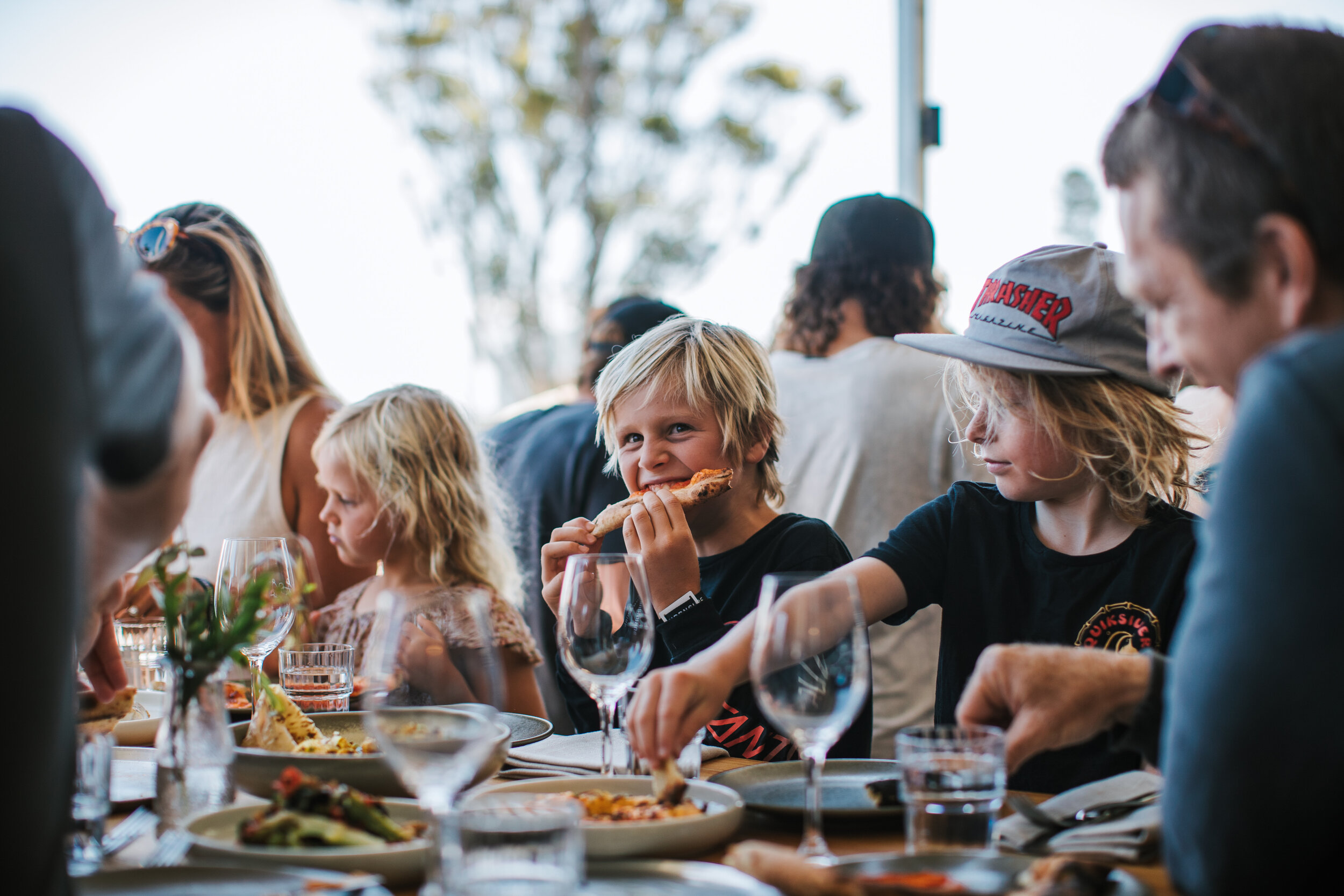
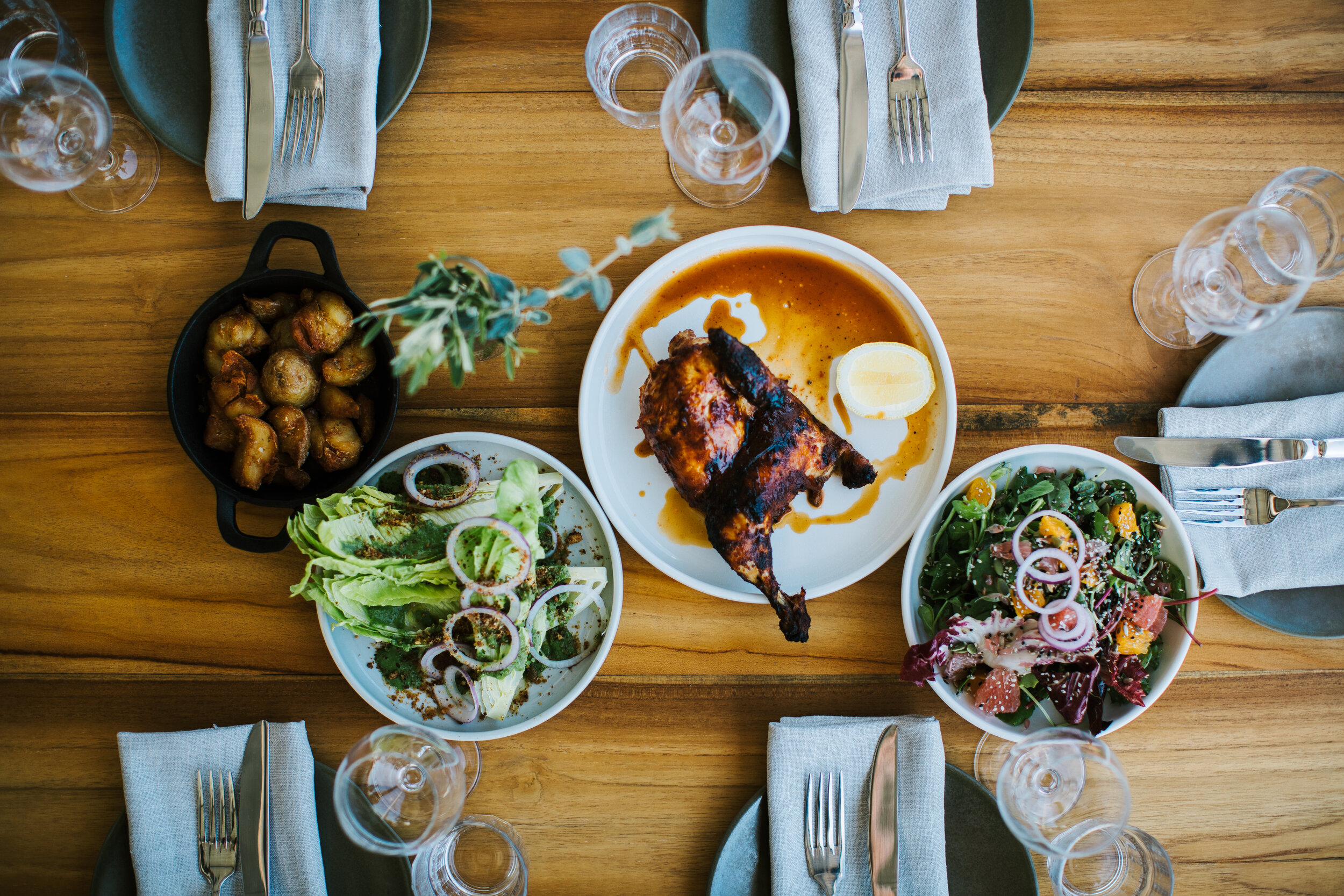

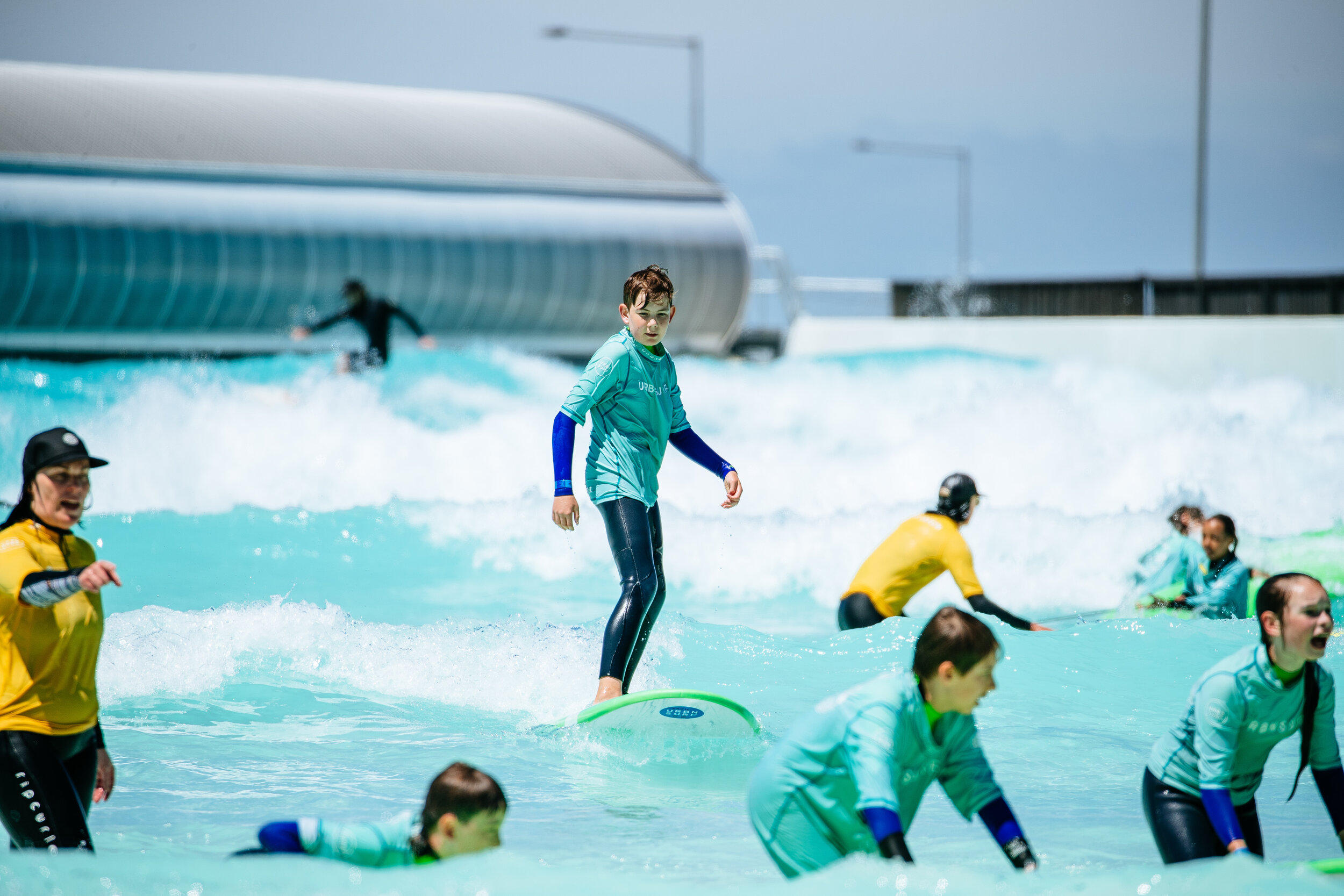
It probably takes two sessions to really get the setup wired, to stop feeling wracked with nerves when you get to the front of the queue and start exploring the wave’s potential. It’s difficult to read the wave, as it doesn’t seem to flag what it’s about to do like an ocean wave and it’s only through repetition that you really get to know it. The intermediate session allows for three or four turns before it peters out, and the advanced setting allows for more critical turns until the halfway mark of the session, when it is all about the barrel.
The pool is oriented to be offshore in a northerly, just like Victoria’s ocean coast, because that’s the prevailing wind in Tullamarine and what the site lent itself too. Subtle tweaks to the settings compensate for onshore or offshore winds. The barrels are definitely more open in an offshore, but the pool handles an onshore remarkably well, sheltered as it is by the concrete wall around its perimeter.
The reformed whitewater waves allow beginners to have learn-to-surf sessions in the shallow “bay” so that nothing goes to waste. There are regular lessons and a well-stocked hire shop with all the boards and wetsuits any level of surfer could need.
At $79 for a casual session, or $700 for a block of ten, and 10 to 12 waves per session, it works out to about $7 or $8 per wave, which most surfers would regard as reasonable value for money. If you did the maths on a high-end boat trip it would probably work out at a similar price. A monthly membership makes it even more affordable.
“It’s become normalised,” says Rupert, of the Melbourne-based surfers who seem to have seamlessly integrated the pool into their surfing lives. “Members have a surf a week for $250/month, or around $63 a surf. It costs about the same to go down the coast. Do I make the drive, or do I go get 12 waves and get on with my life?”
Is there a moral or ethical issue in riding man-made waves in the age of climate change? UrbnSurf claims that as long as you live at least a 15-minute drive closer to the pool than the ocean, your carbon footprint is smaller surfing the pool rather than driving to the coast. Solar panels supplement the energy supply, and the plan is to power it by 100% renewable energy eventually. The appeal of getting new boards quickly dialled, advancing technique or keeping the ravages of age at bay and maintaining performance levels are obvious. “We have members who come 20 times a month, five times a week. That’s their gym now,” says Rupert.
No wave pool is ever going to take the place of the ocean, but UrbnSurf’s location near Tullamarine seems to be a master stroke. I know interstate surfers who have done FIFO missions down for the day when border restrictions have allowed. I bumped into old mates having a 60th birthday celebration with day-long sessions, because their regular Mentawai boat trip was off the cards. I met one bloke who’d taken a lunch break from his St Kilda Rd office to duck in for a quick surf. Once, bored Melbourne businessmen in unfulfilling jobs would visit sleazy lingerie restaurants and gentleman’s clubs to try and fill the dark void in their soul. Going for a lunch time surf in a wave pool seems like an altogether healthier option.
Victoria’s notoriously wild weather mean’s the ocean coast can be rendered unsurfable for days and even weeks on end by arctic onshores. I bumped into mates who’d driven up from Phillip Island to surf the pool, and I know plenty of Melbourne-based surfers who schedule regular sessions as a part of their surfing lives when they can’t make it to the coast.
When I get home to the Gold Coast, my 15-year-old grommet is absolutely filthy that I’ve been to UrbnSurf without him. While purists might decry the rise of wave pools, I’d argue that horse has well and truly bolted. For a younger generation who have grown up with Netflix and Uber Eats and Spotify, the pool represents the sort of on-tap convenience they’ve become accustomed to and many want to be able to schedule into their surfing lives.
UrbnSurf is soon to break ground on a Sydney pool near Olympic Park and have plans for others in Perth, Adelaide, Brisbane, and larger regional centres. Their stated goal is 10 new wave parks in 10 years. Its founder Andrew Ross, meanwhile, has stepped away from his creation to take up an opportunity as a partner with an international wave park business, Aventuur, which has exclusive rights to the Wave Garden technology in several key international markets. The wave park race is well and truly on. Kelly’s wave may be longer, Surf Lakes might accommodate more surfers with greater variety, but none have created a viable business model and been embraced by regular surfers as quickly as Wave Garden and UrbnSurf.
Is surfing losing something essential but intangible with the rise of wave pools? “Whatever we did, I didn’t want to fuck up surfing,” says Andrew, although he admits his own recent surfs in the ocean have proven challenging – the drop ins, the hassling, the capricious conditions – compared to the ease, consistency and convenience of the pool.
If wave pools aren’t your jam, no one’s holding a gun to your head to ride the things, and the ocean always awaits, vast, blue and free, with all its fickleness and beauty, it’s hazards and mystique. If surfers are addicts and the ocean is our drug, then wave pools provide a pretty convenient methadone program.
I’ll be back, and with my grommet next time.
To find out more or to book a session go to the UrbnSurf website
The author immerses himself in his subject


